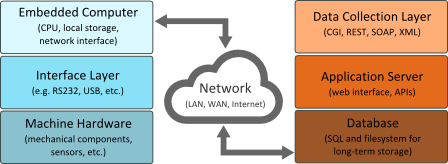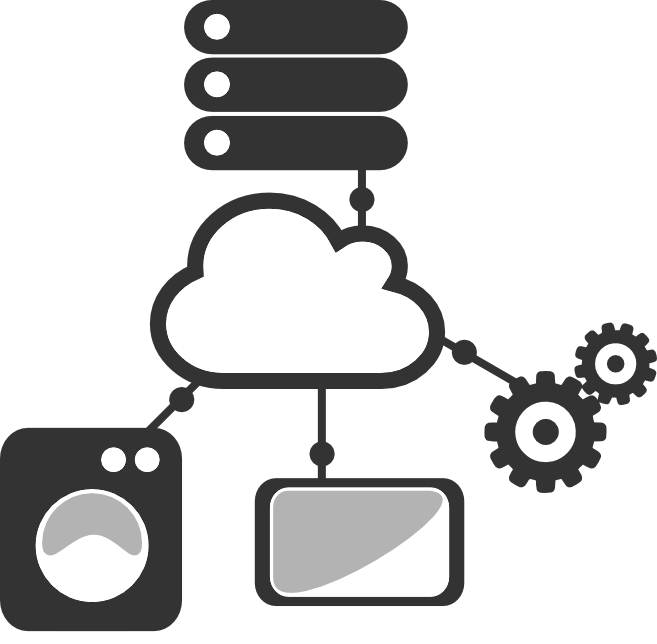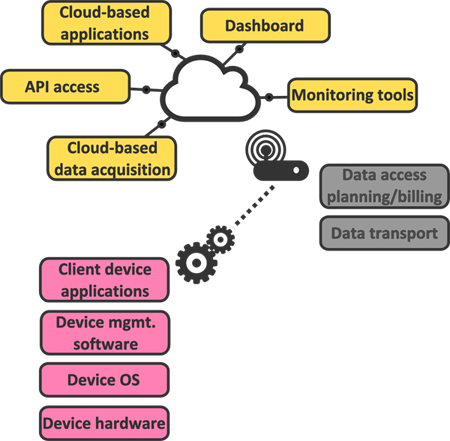What is FireCast M2M?
 Machine-to-Machine (M2M) applications allow computers, industrial machines, home appliances and other devices to network and communicate with each other. FireCast M2M allows device manfacturers to connect their products to the cloud and instantly benefit from remote control and monitoring capabilities, centralized data collection, and graphical display. Similarly, product development firms (PDs) can use the FireCast M2M platform to add these features to their clients' products, without the cost and delays associated with creating a solution from scratch.
Machine-to-Machine (M2M) applications allow computers, industrial machines, home appliances and other devices to network and communicate with each other. FireCast M2M allows device manfacturers to connect their products to the cloud and instantly benefit from remote control and monitoring capabilities, centralized data collection, and graphical display. Similarly, product development firms (PDs) can use the FireCast M2M platform to add these features to their clients' products, without the cost and delays associated with creating a solution from scratch.
Using FireCast M2M, a vending machine can report its inventory to the people who restock it, a parking meter can transmit its transaction history and availability, and a rooftop A/C unit can send diagnostics to its manufacturer or maintenance company without requiring a truck roll. Consumer-facing devices might do all of these things while displaying advertising content on an attached LCD display, making content selection choices based on a combination of internal sensor data and external information like the local weather.
It's time to learn more about adding FireCast M2M to your products -- or the products you're developing for your clients. Contact Us
What does a FireCast M2M-enabled product look like?
f'real foods operates a network of interactive, self-service blenders that make it easy for consumers to blend milkshakes, smoothies, and frozen cappuccinos on demand. f'real's blenders can be found in over 10,000 locations worldwide, including convenience stores, colleges and universities, movie theaters, and military bases.
f'real's blender network is powered by the WireSpring M2M platform, including FireCast OS and FireCast ClientCenter Cloud.
Watch the video to learn more.
How FireCast M2M services enhance your products
Adding smart features to industrial machinery, commercial appliances and consumer devices can not only enhance product functionality and increase utilization rates, but also reduce service and support costs and systemic process errors. Some common features that an M2M platform can enable include:
Remote Monitoring
Each device can check in to provide a snapshot of its current status and download new commands. Check-ins may entail using simple "heartbeats" at fixed intervals, or maintaining a persistent connection to the cloud.
Remote Management
Change settings and query local sensors and controls on a unit-by-unit basis or in groups of your choosing.
Remote Diagnostics
Run automated scripts to test your equipment and generate reports on predetermined schedules.
Service Support
Provide on-site support agents with remote assistance or on-screen cues for performing common maintenance tasks.
Software Revision Control
Deploy remote software and firmware updates to your devices over the network, and receive confirmation that they were installed successfully.
Content Management
Control user interfaces, multimedia content and mobile applications from a single location.
Graphical Display
Show information about your devices in real-time -- remotely, on the device itself, or both. Target end-users or potential customers with high-definition imagery, video and data visualizations.
Centralized Data Collection
Accumulate data from all of your devices and analyze it at your leisure, either on your own computer or in the cloud.
Custom Dashboards
Create complex data visualizations to quickly illustrate how your devices are performing.
Data Analytics and Reporting
Use built-in reporting tools to generate graphical tables and charts for all of your critical data. Or use web-based APIs to export the data to a location and format of your choosing.
Understanding the FireCast M2M Stack

Connected devices use a specialized software stack running on top of custom or commodity computer hardware to communicate with a remote server over a network (by Ethernet, WiFi, cellular, etc.). The server, in turn, runs software that allows administrators to monitor and control the devices' behavior.
However, planning a project requires going into more detail. Devices must either be designed to handle networked communication, or be retrofitted with a module that can do so. A software stack must be implemented to monitor and control the device hardware. The data must be collected by server software and stored so that it can be usefully retrieved later. And all of this must be presented to the device owners or network operators in a useful, manageable way.
As your project spins up, there will be more details to consider. For example, if the project calls for cellular communication, you'll need to consider the type of modem to deploy, your international expansion plans (since different countries use different cellular technology), and whether it makes sense to embed the cellular radios into your device, or leave them separate so they can be swapped out later.
You'll also have to decide what kind of software platform to build your application on, and whether to do the development in-house, or contract it out to specialists. If your plan calls for thousands of devices (or more), you'll need to keep scalability in mind. All projects will have to plan for long-term code maintenance and allow for new feature development. After all, one of the biggest selling points of M2M solutions is the ability to update device software and firmware remotely -- so why wouldn't you plan on taking advantage of that?
When planning your M2M project, consider the following:
Your Device Hardware
OEMs and ODMs planning the next revisions to their product lines should consider which low-level changes may be needed to enable M2M functionality. Device hardware that is already microcontroller-driven, or has a controller board with an RS-232 or JTAG debugging port, is already well-prepared to add M2M services via an add-on M2M module. Devices with only simple control circuitry may need some changes before they're ready to connect.
M2M Embedded Module
Many popular hobbyist boards (like the Raspberry Pi and BeagleBone) offer a low-cost way to rapidly prototype M2M solutions, and many solution providers offer application-specific system boards for project development. Take volume production, product availability, configurability and networking options into account when considering a hardware platform. And most importantly, never select a hardware platform before deciding what the application software is supposed to do!
OS / M2M Software
Connected devices must be designed to operate remotely with little or no direct supervision or intervention for long periods of time. Consequently, some M2M companies offer whole-OS solutions featuring self-healing architecture, remote OS upgrade capability and low-level system access, in addition to a suite of more typical M2M features. Others focus on application enablement software that sits on top of an existing OS and provides graphical display, data collection and cloud communications functionality. Some, like WireSpring, do both.
Network Connectivity
Not every M2M application needs to connect to the cloud over a cellular network. Some applications leverage a host venue's existing wired or WiFi network to connect to a remote cloud service, while others perform all communications within a corporate VLAN. A well-designed M2M hardware and software stack should be flexible enough to handle any network configuration that might be required.
Management Software
Central management for M2M applications is a must. A well-designed M2M solution should ideally be able to run as a cloud service, as a premise-hosted solution, or in a virtual container, depending on project needs.
Software APIs
The M2M platform should take advantage of software APIs at the device, transport and management levels to make sure that the right data is exchanged, and that the system can be directly integrated into existing and new business processes.
Professional Services
Many connected device OEMs don't want to be their own software development house. The best M2M platform providers are eager to assist device manufacturers and product development firms at every stage of a project, from advising on hardware changes and M2M modules, to writing custom applications and building out any required business logic.
Selecting an M2M platform
WireSpring's M2M solutions aim to make the development and deployment of connected devices straightforward, scalable, and bulletproof. The platform includes the connected device's operating system, the M2M application framework, the remote management software, the cloud dashboard and management tools, and APIs to integrate with your legacy systems. Our professional services staff has deployed hundreds of unique projects over the past 15 years, and is prepared to assist with hardware selection, network requirements and custom software needs.
Thinking about adding M2M features to your products? It's never too early to start the planning process, and our team is here to help you every step of the way.
 Machine-to-Machine (M2M) applications allow computers, industrial machines, home appliances and other devices to network and communicate with each other. FireCast M2M allows device manfacturers to connect their products to the cloud and instantly benefit from remote control and monitoring capabilities, centralized data collection, and graphical display. Similarly, product development firms (PDs) can use the FireCast M2M platform to add these features to their clients' products, without the cost and delays associated with creating a solution from scratch.
Machine-to-Machine (M2M) applications allow computers, industrial machines, home appliances and other devices to network and communicate with each other. FireCast M2M allows device manfacturers to connect their products to the cloud and instantly benefit from remote control and monitoring capabilities, centralized data collection, and graphical display. Similarly, product development firms (PDs) can use the FireCast M2M platform to add these features to their clients' products, without the cost and delays associated with creating a solution from scratch.


